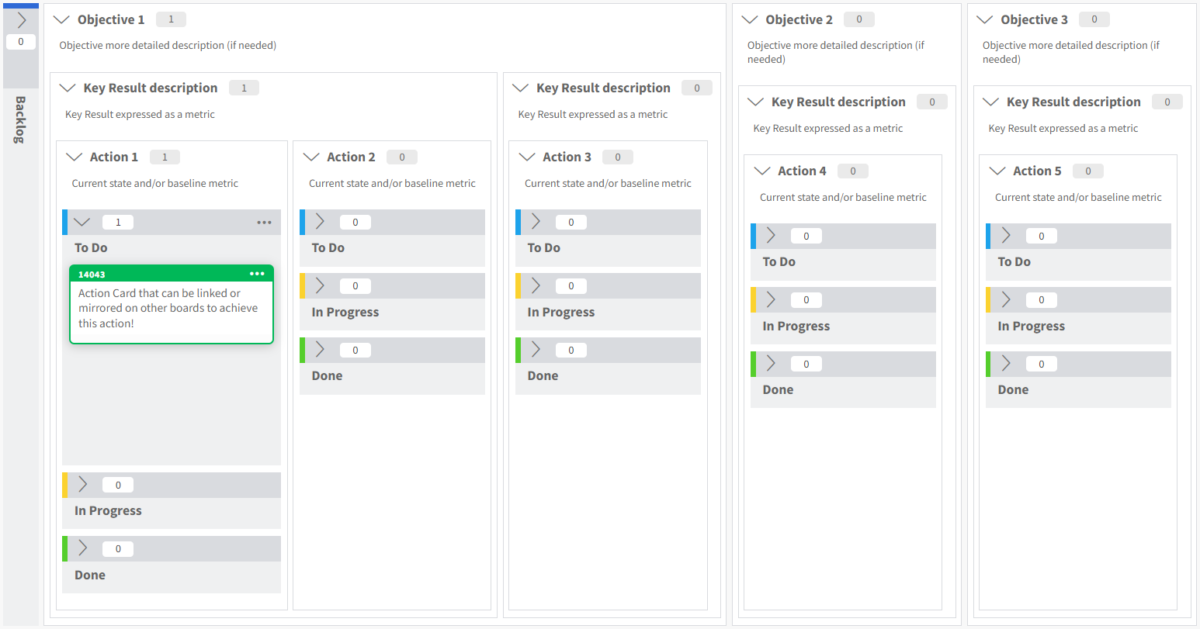
Enhancing team performance, employee happiness, and achieving better results are top priorities for managers and company leaders in any organization. However, that is not an easy task without the right tools and the knowledge to implement them.
Among all the different methodologies and frameworks for successful planning and goal-setting, the OKRs (Objectives and Key Results) stand out as one of the best and can play a vital role in your team’s success.
Well-written OKRs provide a well-outlined path to achieving them. They give your team a sense of direction, enable them to focus on what’s truly important, and help you get your priorities straight.
But how do you make the most of OKRs? Visual management systems like Kanban offer a powerful solution by allowing teams to visualize their goals and track real-time progress. In this article, we’ll share the best practices for defining and implementing OKRs visually, ensuring that you can lead your team to success.
Understanding the Basics of OKRs
OKRs is a goal management methodology that enables organizations to achieve their objectives based on key results. These goals can be long-term or short-term, with measurement periods ranging from a week to a year. To use OKRs, organizations must identify their objectives and create key results to monitor their success.
The framework consists of two main parts: objectives and key results.
Objectives are qualitative statements that outline what you want to achieve. They provide direction for the team and enable them to focus on tangible goals rather than vague ones.
Key results are quantitative metrics that measure how you will achieve the objectives. They are specific, measurable, and time-bound and serve as a tracker to show progress toward goals.
Best Practices for OKR Creation
How you plan and write your OKRs can make or break your team’s success.
The basic formula you should use for your OKRs is the following:
I will [Objective], as measured by [Key Results].
However, OKRs are not merely some tasks for your team to cross off their to-do lists. They are part of bigger goals that will improve your organization and allow it to achieve more in the future while providing scalable services and innovative products.
Some general OKR best practices will ensure your objectives and key results are truly effective.

OKRs Best Practice #1: Plan Your OKRs Thoroughly
Planning your OKRs is the first step in the process of creating your goals and streamlining the company’s objectives for a certain period. Only with effective OKR planning you can streamline your workflow in a way that is oriented toward achieving your goals.
OKRs Best Practice #2: Align OKRs with Organizational Goals
OKRs should be aligned with the company’s strategic objectives, ensuring that each team’s efforts contribute to the company’s mission and vision. Understanding the organization’s goals helps in breaking down higher-level goals into actionable team OKRs. This also ensures that everyone stays aligned and moving in the same direction.
OKRs Best Practice #3: Involve the Team in the Process
Involve team members in goal-setting to foster a sense of ownership and involvement. Organize group brainstorming or workshop sessions where team members can participate in identifying goals and important outcomes. This strategy makes sure that everyone is on the same page and dedicated to reaching the objectives.
However, you need to remember that objectives and key results are two different things and there are distinctions in the OKRs best practices for both.
| Objectives | Key Results |
|---|---|
| Memorable, qualitative descriptions of what you want to achieve | A set of metrics that measure your progress toward the objective |
| Should be short, inspirational, and engaging | Need to support their attached Objective |
| Should motivate and challenge the team | Should be relevant to your objective and easy to measure with a number |
| The destination you’re heading toward | The map to getting there |
| A maximum of three to five objectives per team per quarter | For each objective, you should have a set of two to five key results |
OKRs Best Practice #4: Set Ambitious Yet Achievable Objectives
Setting ambitious objectives requires balancing creativity and innovation with being realistic and attainable. It’s crucial to ensure the objectives challenge the team while remaining feasible, considering their capabilities and resources.
OKRs Best Practice #5: Ensure Measurability of Key Results
Key Results should be specific, measurable, and time-bound to enable tracking and evaluation. Use clear metrics and numbers when defining Key Results.
Best Practices for OKR Implementation
Writing good and effective OKRs will only get you so far. Too many organizations start with the best of intentions when it comes to OKRs. They do the work of brainstorming across their teams. They put their OKRs into great-looking templates. Then, sadly, they put them on a shared drive and forget about them. So how to make sure your OKRs work for you?
OKRs Best Practice #6: Organize a Pilot Program
Doing anything at scale is complex, especially OKRs. That’s where pilot projects come in. For small and medium-sized organizations, this is a great first step to testing the OKR process with a small team or a project. Monitor progress and gather feedback from the team to refine the process and address any challenges before expanding to other teams.
OKRs Best Practice #7: Regular Check-ins and Reviews
Hold weekly or bi-weekly meetings to review progress and discuss any issues or roadblocks. This is essential to assess progress, address challenges, and make necessary adjustments to the OKRs to ensure that everyone is on track to achieve the objectives.
Best Practices for OKRs Visualization with Kanban
Like any project, having the right tool for the job is critical. From brainstorming sessions on goals and objectives to tracking your progress, excellent tools are available to help support and stay aligned on your OKRs — especially when you’re working in a remote or hybrid workplace.
This is where Kanban comes into play.A great starting point is our OKRs Kanban board template, with columns representing different stages of progress (e.g., To-Do, In Progress, Done, Blocked). Use cards to represent each key result and move them across the board as progress is made, including details on each card about the tasks and metrics. As you move forward, you can modify and improve the system to better fit your team and OKRs.

Visualize your OKRs with a Kanban board and track your team’s progress more efficiently. Find out how Kanban Zone can make OKR tracking easier.
As an added benefit, you can leverage Kanban Zone’s ability to link cards together and visualize the connection of every key result card to the objective it serves. Connections are super easy and quick to set up and remove any possibility of confusion.
Benefits of Using Kanban for OKRs
- Visibility and Transparency: Kanban boards make OKRs and their progress visible to all team members, fostering a culture of transparency and accountability.
- Flexibility and Adaptability: Kanban allows teams to adapt their OKRs as circumstances change, ensuring that goals remain relevant and achievable.
- Collaboration and Accountability: Kanban boards promote collaboration by making it easy for team members to see what others are working on and how their efforts contribute to the team’s objectives.
OKRs Best Practice #8: Transparent Communication
Your OKRs should be visible and accessible to all team members to promote transparency and accountability. By using visual management tools like Kanban boards to display OKRs and progress you can ensure transparent communication across all teams. Regularly update these boards to reflect the current status of each objective and key result.
OKRs Best Practice #9: Celebrate Successes and Learn from Failures
It’s crucial to recognize and celebrate achievements when OKRs are met and conduct retrospectives to learn from any failures. Hold end-of-quarter reviews to assess the success of OKRs, celebrate accomplishments, and discuss lessons learned. Kanban is also a great tool to easily visualize your success and manage your OKRs better. This ensures your team is motivated and you have valuable insights for improving the OKR process for the next cycle.
OKRs Best Practice #10: Track and Adjust Them Consistently
OKRs work best when you track and review them. Find ways to make OKR reviews part of your process. That could be reviewing individual OKRs at 1:1s, team OKRs at weekly team meetings, or organizational OKRs during quarterly town hall meetings.
Prioritizing OKRs and managing the workflow effectively is also crucial for your success. By using the Kanban principles you can make sure that the most critical objectives are addressed first at any given moment. It’s also important to limit the number of Key Results in progress at any given time to prevent overloading the team. Prioritize OKRs based on their impact and urgency, and use Kanban’s pull system to manage the flow of work.
Ready to Implement OKRs for Your Team?
OKRs are a great way to manage the flow of work efficiently, especially for knowledge work teams—such as those in IT, Legal, and Marketing. They make establishing clear goals and tracking progress towards these objectives significantly easier.
Implementing OKRs in a visual way with Kanban Zone’s OKRs board template can transform the way your team operates, leading to better alignment, focus, and results. Follow the best practices outlined in this article and leverage the power of visual management systems like Kanban to make your team’s goals and progress more visible, manageable, and adaptable.
Sign up for a free trial of Kanban Zone to experience the benefits of visual management even better and see how it can transform your team’s approach to OKRs.
Learn to Work Smarter, Not Harder!
Get our top articles weekly.
Table Of Contents
Discover many more posts…







